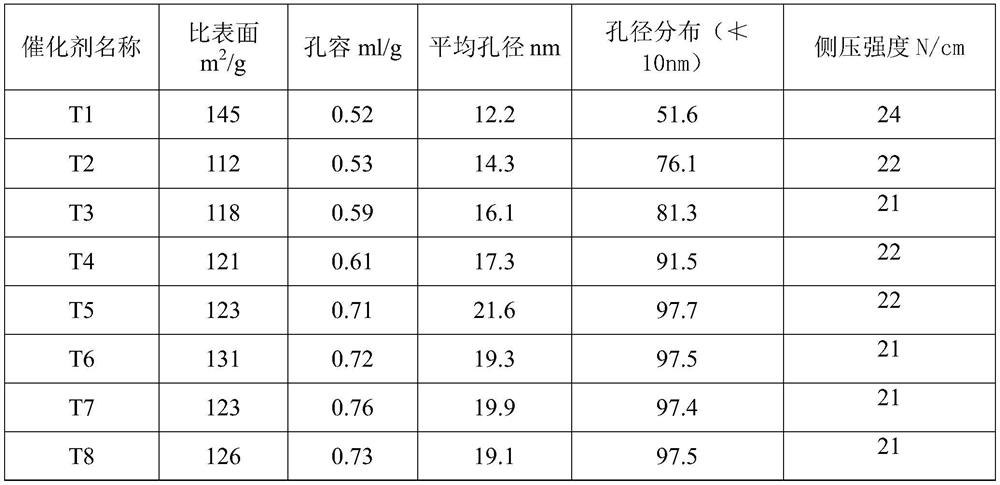A catalytic gasoline hydrogenation dearsenic agent and its preparation method and application
A technology for catalytic gasoline and arsenic removal, which is applied in chemical instruments and methods, physical/chemical process catalysts, heterogeneous catalyst chemical elements, etc. The arsenic removal activity and selectivity of the material content have a great influence, restricting the arsenic removal activity and service life of the arsenic removal agent, and achieving the effect of large average pore size, strong operability, and strong carbon capacity
- Summary
- Abstract
- Description
- Claims
- Application Information
AI Technical Summary
Problems solved by technology
Method used
Image
Examples
preparation example Construction
[0039] A preparation method of catalytic gasoline hydrogenation dearsenic agent, comprising the following steps:
[0040] Step 1: Mix alumina or a mixture of alumina and titanium oxide with scallop powder evenly, add organic polymer pore-forming agent, binder and deionized water, knead, extrude, and dry at 100-150°C for 3-6 hours , heat treatment at 650-1000°C for 3-6 hours at high temperature to prepare arsenic-removing agent carrier;
[0041] Step 2: The arsenic removal agent carrier is subjected to hydrothermal treatment to expand the pores, the treatment temperature is 400-700°C, and the mass space velocity is 0.5-1.5h -1 , treated for 1-10 hours to obtain arsenic-removing agent-modified carrier;
[0042] Step 3, dissolve the active components nickel salt and molybdenum salt in one or more of citric acid, ammonia water and deionized water to form a stable two-component active metal complex solution, and then use the two-component active metal complex Immerse the modified...
Embodiment 1
[0049] Weigh 100g of pseudo-boehmite, add 3.0g of fenugreek powder, and then add 3% nitric acid aqueous solution, knead and extrude, dry at 120°C for 4h, and then roast at 750°C for 4h to obtain arsenic removal agent carrier A (see Table 1 for properties). Weigh 20.0g of the carrier and put it into a beaker, add excess deionized water and let it stand for 3 hours, then remove the excess water on the surface of the carrier, compare the weight w1 of the carrier before immersion and the weight w2 of the carrier after immersion to calculate its water absorption, and then follow the equal volume immersion method , according to the water absorption of the carrier, the preparation of the active component impregnation solution is carried out. First weigh 60ml of ammonia water, then add 30g of nickel acetate and 3.7g of ammonium molybdate and stir until dissolved, and finally dilute with ammonia water. The carrier was impregnated by an equal volume impregnation method, so that the cat...
Embodiment 2
[0051] Weigh out 3% TiO 2 Add 100g of pseudo-boehmite to 100g of pseudo-boehmite, add 3.0g of fenugreek powder, 5g of organic polymer pore-forming agent polyvinyl alcohol with a particle size of 200μm, and then add 3% aqueous nitric acid solution, knead, extrude, and dry at 120°C for 4h , and then roasted at 750°C for 4h, then hydrothermally treated, the treatment conditions are: reaction temperature 600°C, mass space velocity 0.5h -1 , 4h, prepared carrier B (properties are shown in Table 1). The metal active component impregnation method, impregnation amount of nickel salt and molybdenum salt, drying and roasting conditions were the same as those in Example 1, and arsenic removal agent sample T2 was obtained.
PUM
| Property | Measurement | Unit |
|---|---|---|
| pore size | aaaaa | aaaaa |
| pore size | aaaaa | aaaaa |
| pore size | aaaaa | aaaaa |
Abstract
Description
Claims
Application Information
 Login to View More
Login to View More - R&D
- Intellectual Property
- Life Sciences
- Materials
- Tech Scout
- Unparalleled Data Quality
- Higher Quality Content
- 60% Fewer Hallucinations
Browse by: Latest US Patents, China's latest patents, Technical Efficacy Thesaurus, Application Domain, Technology Topic, Popular Technical Reports.
© 2025 PatSnap. All rights reserved.Legal|Privacy policy|Modern Slavery Act Transparency Statement|Sitemap|About US| Contact US: help@patsnap.com



